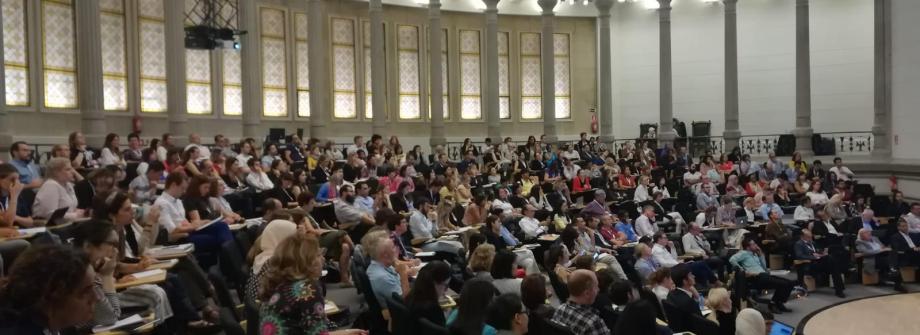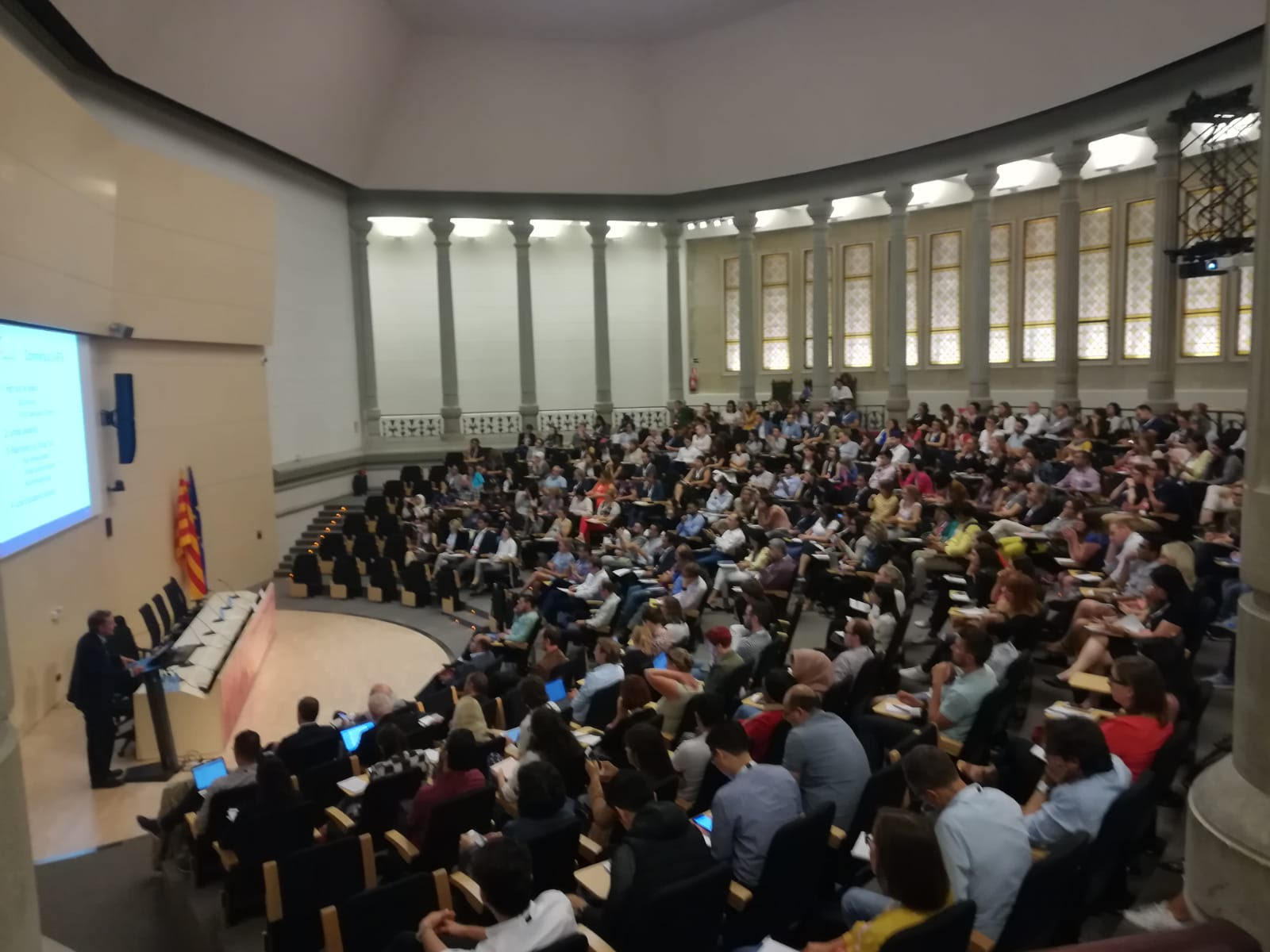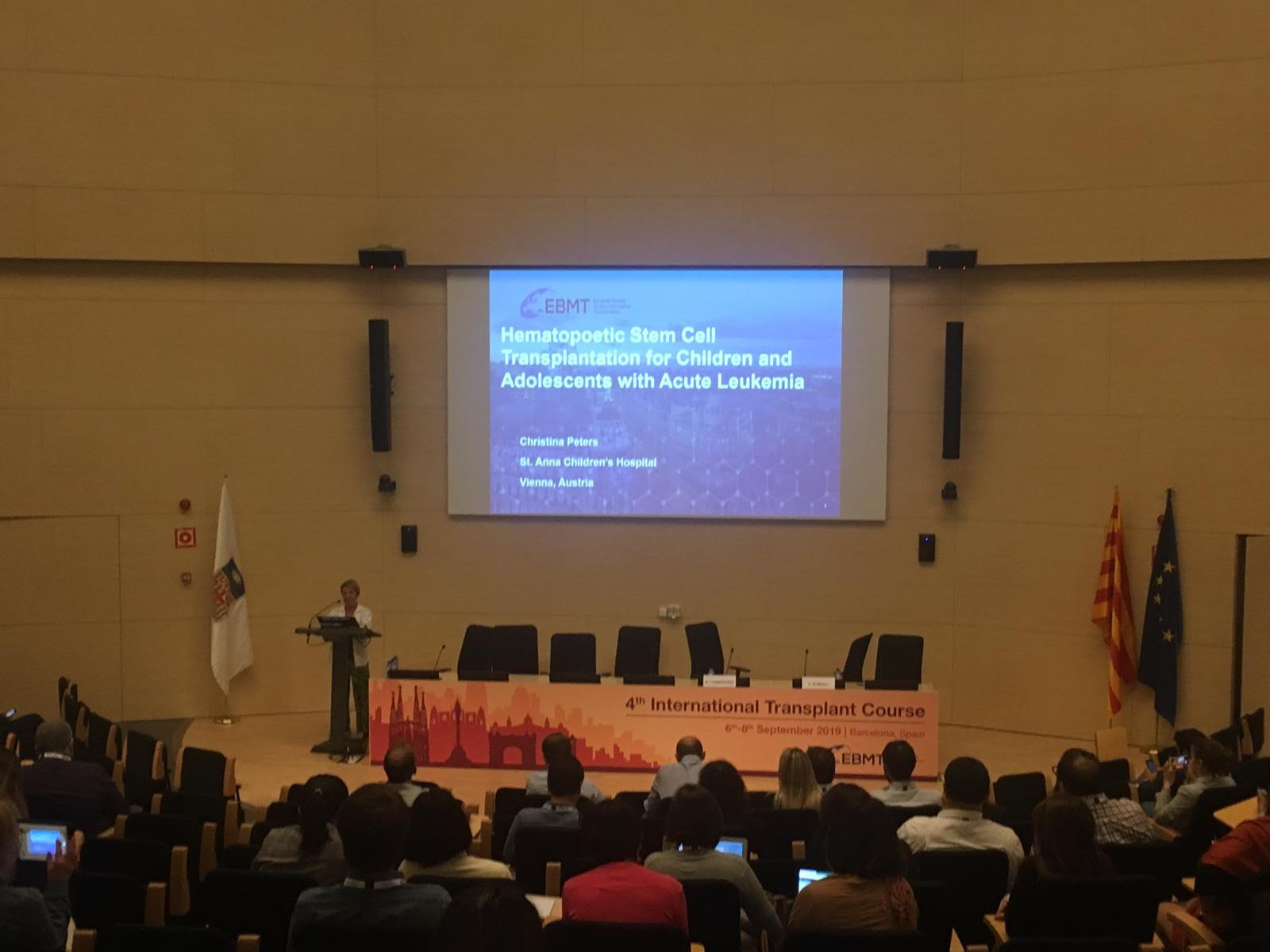
The 4th EBMT International Transplant course took place in Barcelona on 6-8 September 2019. This ever increasingly attended event welcomed more than 300 participants not only from Europe but also from Brazil, Pakistan and Korea.
The EBMT-ITC is a major event to disseminate knowledge, and advance education in the fields of stem cell transplantation and cellular therapy. It allows young physicians and nurses to learn from the most experienced practitioners but also to present their clinical case reports and receive advice from the participants.
Topics included hematopoietic cell transplantations and cellular therapies; diseases and indications; transplant complications and transplant and cellular therapies management.
The EBMT is always committed to the quality of care. For the first time this year, a nurses group day was incorporated to the programme. On Saturday, more than 70 nurses gathered to hear about nursing care in the cellular therapy setting, complications of cellular therapy and supportive care.
A group of six attendees and speakers agreed to report about their experience and chronicle some sessions. You can read their full reports below.
Physicians Sessions – Friday 6th September 2019
Session II: T-cell engineering and CAR T cells academia: where do we stand – A. Urbano-Ispizua
Summary by Laura Van Hussen Daenen, Fellow hematology at UMC Utrecht, The Netherlands
Dr Urbano-Ispizua started his talk by explaining T cell function after allogeneic stem cell transplantation (alloSCT). After alloSCT there is a balance between graft-versus-leukemia (GVL) and graft-versus-host-disease (GVHD). T cell engineering is a novel treatment option that provides the possibility to exploit the T cell-mediated anti-tumor effect without the negative effects of GVHD. An example of engineered T cells are CAR T cells.
Next, the production process of CAR T cells was explained. To generate CAR T cells, T cells are expanded and transduced with a gene encoding the chimeric antigen receptor. The resulting CAR T cell has a receptor with an extracellular antigen-binding domain, a transmembrane domain and an intracellular domain containing one or more costimulatory domain. These costimulatory domains, e.g. CD28 or 4-1BB, can activate T cells upon interaction with tumor cells, even if the tumor cells have downregulated their costimulatory proteins. For the treatment of B cell diseases, CD19 is a good target for CAR T cells since CD19 is exclusively expressed on B cells. Two commercial CD19-targeting CARs are on the market.
There are some disadvantages to CAR T cell therapy, such as the high cost, limited availability and long manufacturing process. A recent EBMT survey on CAR T activity in Europe shows an increasing number of CAR T studies initiated by academia. Dr Urbano-Ispizua explained a clinical trial from the Hospital Cliníc in Barcelona, in which patients with ALL are treated with CD19 CAR T cells manufactured in the local GMP facility. The study has promising results. Twelve patients are treated, 7 of whom are in remission with follow-up of more than 1 year. Initially, toxicity was a problem with procedure-related deaths, a.o. due to cytokine release syndrome. This has improved using fractionated CAR T cell administration, and tocilizumab in case of cytokine release syndrome. Currently, a Spanish multicenter trial with CD19 CAR T cells from the Hospital Cliníc is in preparation.

Physicians sessions – Saturday 7th September 2019
Session VIII: State of the Art Transplantation of Childhood Leukemia - C. Peters
Summary by Zoya Konova, Hematologist in National research center for hematology, Moscow, Russian
In this presentation, Christina Peters focused mainly on allo-HSCT for ALL. She initially noted that the only minority of children with ALL have an indication for allo-HSCT which are based not only upon level of risk but also upon the presence or absence of certain types of donors. However, the ALL-SCT-BFM-2003 Trial has shown that matched donor type (related or unrelated) does not affect on clinical outcome of high-risk pediatric ALL patients. But allo-HSCT from unrelated donor is associated with higher infection rates in pre-engraftment period. According to the 2003 BFM and 2007 International BFM Studies HSCT with a mismatched donor is realizable in pediatric ALL patients but leads to inferior results compared with HSCT with better matched donors. The results are strongly affected by disease status, better outcomes for patient who were transplanted in first complete remission. The main cause of treatment failure is still relapse. The prognosis of relapsed patients is dismal. The 3-year event-free survival was 15% and overall survival was 20%. Another problem is an increased risk of solid cancers among transplant recipients, particularly those irradiated at young ages. The way to reduce the probability of development this severe complication is to replace TBI with chemo-conditioning. But according to ALL SCTped FORUM study OS of patients after allo-HSCT with TBI-based conditioning is significantly better comparing to chemo-conditioning group due to the higher relapse incidence. TRM is almost identical in both groups. So, TBI/etoposide is still the most optimal conditioning for children above 4 years.

Physicians Sessions – Sunday 8th September 2019
Session IX: Keynote Lecture: Modulation of the microbiota at the era of cellular therapy - J. Peled
Summary by Shu Min Wong, CART fellow, Kings College London Hospital, UK
Changes in the composition of the gut microbiota have been linked with patient survival post allogeneic haematopoetic stem cell transplantation (allo-HCT). In this session Dr Peled discussed the role of intestinal microbiota in modulating the niche between bacterial and host and the role it plays in GVHD. In a study looking at 1300 patients in 4 centres with 8000 faecal samples across different transplant centres, loss of diversity of microbes over the course of transplantation resulted in lower survival rate and increased transplant related mortality.
One possible explanation for this is the use of broad-spectrum antibiotics. Comparing different antibiotics and its role in GVHD related mortality. An analysis of 857 recipients showed that piperacillin -tazobactam and imipenem were associated with increased GVHD mortality compared to Cefipime, which may spare the microbiota, this will need further investigation.
With this in mind Dr Peled talked about approaches to manipulating host-microbiota through antibiotics (gut decontamination), post-biotics, pre-biotics (high calorie intake increases high diversity) and pro-biotics. Of the intestinal pathogens, patients who are dominated with enterococcus have higher incidence of acute GVHD Grade 3-4. Enterococcus is able to metabolise lactose and in GVHD there is a deficient of lactase, which increases its availability for enterococcus. Dr Peled proposes a trial looking at implementing lactase as a pre-biotic.
Finally, Dr Peled covered the re-discovery of faecal transplantation as a therapy for Clostridum difficile infection and postulated whether a similar approach can be implemented in allo-HCT patients to increase the diversity of microbes after transplantation.
Nurses Sessions – Saturday 7th September
Session I: Welcome and Introduction
Introduction - J. Murray
Introduction to current perspectives in cellular therapy - J. Cano
Paediatric considerations inc TYA - J. Ruiz
Adult considerations inc elderly - V. Antoine
Important nursing considerations of immune effector cellular therapy common - R. Ellard
Case Presentation
Summary by Sandra Schoenfeld, Clinical Nurse Specialist Haematology, Universitätsspital, Basel, Switzerland
The Nursing Day at the International Transplant Course took place Saturday morning. The agenda highlighted four very important and current topics that concern us in caring for haematological patients. There was a focus on cellular therapy, including both paediatric (including AYA) and adult considerations (including elderly).
Josefa Cano (Barcelona) presented the experiences of her ward with CAR-T cells She addressed the needs of the patient and what happens to a patient during the hospitalization.
This was followed by a presentation from Julia Ruiz (Madrid) pointing out the main differences of paediatrics compared to adult patients. In paediatrics, for example, other diagnoses lead to an indication for HSCT. Furthermore, patients need to receive age appropriate information and of course parents must be included in decision-making. In addition, children after HSCT survive longer, which brings along new difficulties, e.g. co-morbidities or risk assessments. Afterwards, Dr. Valéry Antoine (Nîmes) focussed on adult and elderly patients in haematology. Here, risk/benefit considerations are more in the foreground. However, we should not forget that two elderly patients with the same age may not have the same physical condition. This needs to be considered for planning a therapy. . In elderly patients, the risk of under treatment due to age is more common than in other age groups. The focus should be put more on physical function than just on age alone. The cognitive function is important in view of: Did the patient understand what will be done with him or her.
Rose Ellard (London) finished the session with a more detailed look into CAR T cells and their side effects. Her presentation focused on the main toxicities including Cytokine Release syndrome (CRS) and neurotoxicity. Due to the unpredictability of the time and the intensity of the occurrence, training and education is of utmost importance along with appropriate staffing and retention.
Session III: Complications of cellular therapy
GvHD - J. Murray
Complications concerning autologous transplantation - M. de Ruijter
Viral complications (paediatric & adult) - I. Agreiter
Late complications and quality of life - M. Kenyon
Summary by Marta Canesi, Staff Nurse, Paediatric Haematology BMT Unit, Fondazione MBBM/ASST, Monza, Italy
The third session of Saturday covered complications of cellular therapy, including both physical and emotional issues.
John Murray (Manchester) opened the session and highlighted aGVHD as the main responsibility of mortality and quality of life influencing factors in patients after HSCT. John gave a comprehensive overview of GVHD, including how it develops, which organs are mainly affected, which are the diagnostic criteria and the current treatment options. He underlined the importance of the differential diagnosis and a comprehensive care of patients affected, through dedicated clinics where nurses play an essential role within a multidisciplinary team. Patient and family information and empowerment are as important as the standard treatment: patients’ stories and experiences are particularly rich of opportunities to understand what to be affected by GVHD is and to identify the priorities of care and treatment.
Next, Maaike de Ruijter (Amsterdam) dedicated her talk to complications related to autoHSCT. Treatment of which has improved greatly over the last 10 years. Together with oral mucositis, infections, bleeding and thrombotic complications, one of the main issues related to this HSCT are the GI complications. In particular, CMV colitis and infection are quite rare but their manifestations are severe and the treatment can have significant toxicities and adverse effects. This has been showed by a clinical case presented from her centre in Amsterdam.
In the next session, Iris Agreiter (Dublin) focused on viral complications in both paediatric and adult HSCT settings, starting from the well-known CMV, EBV, ADV, going through Norovirus (mainly in paediatrics: 22% vs 2%), HHV6, Hepatitis virus. She gave a very interesting overview of what is the viral behaviour in the CAR T cells that represents the new frontier and the new horizon for the treatment of malignancies in many diseases previously treated with standard HSCT.
Lastly, Michelle Kenyon (London) presented the challenges of life after treatment and the impact it can have on patients’ quality of life. People with long-term conditions are intensive users of health and social care services. To reinforce public health messages and to involve patients in opportunities to learn from others (rehab classes, career support) are important goals of who is taking care of them in the post-acute phase. She offered a comprehensive overview of technical evaluations and tools that can be used to evaluate Qol and identify patients concerns, in order to address them. Moreover, it would be ideal to establish patient-family partnership: planning care collaboratively enables them to take responsibilities.
Session IV: Supportive Care
Mindfulness – T. Chase
Psychosocial Care- A. Scherwath
Palliative Care- R. Ting
Summary by Janet Baker, Apheresis Clinical Nurse Specialist, Haemato-Oncology Department, Royal Marsden NHS Trust, Sutton, UK
Collectively, this supportive care session provided a poignant end to a very interesting and thought provoking first nurses meeting, and reiterated the significance of this fundamental aspect of Transplant care.
Troy Chase, a clinical psychologist in the UK, commenced proceedings with a lively overview of Mindfulness, titled ‘Mindfulness- is it any good’?, inviting delegates to make up their own minds following a review of the literature and through participation. He defined Mindfulness as way to purposely focus the mind on the present, as a means of reconnecting with our bodies and the world, and to really ‘notice’ ourselves without ‘judgement’. We participated in two activities and discussed how this technique can be applied to patients, carers, and to nurses. I think by the end even the most sceptical of us were convinced that there is a place for Mindfulness within our practice.
Next, Angela a Psychologist from Hamburg, explored with us the need for better psychosocial care. She began by stating that studies suggest there are many unmet psych-social needs in this patient population and reminded us of the many and varied sources of distress that patients and carers can experience. While excellent education and information can help, she highlighted that current care fails to meet the supportive care needs of patients. To redress this, she discussed the principles of providing a preventive and sustainable approach involving robust pre- assessment of both patients and carers, team work and a multidisciplinary focus. Importantly, she identified the key role nurses play here every day (and night), at the bed side and on the day care units.
Finally, Ruth Ting, a palliative care Consultant from the UK, passionately described an additional layer of support that can contribute to the care of our patients: palliative care. She emphasised that palliative care is not a speciality per se, but rather an attitude, a philosophy, and an approach that can be applied by all of us. This was reflected by the very powerful anecdotes she shared from her clinical practice which supported her guidance of being present, being honest, trying to use the right words, and focussing on what the patient/carer really needs. She explored the fundamentals of good end of life care and our ‘one chance to get it right’. After a very inspirational and emotional talk, she ended with the mantra that ‘palliative care is everyone’s responsibility’.